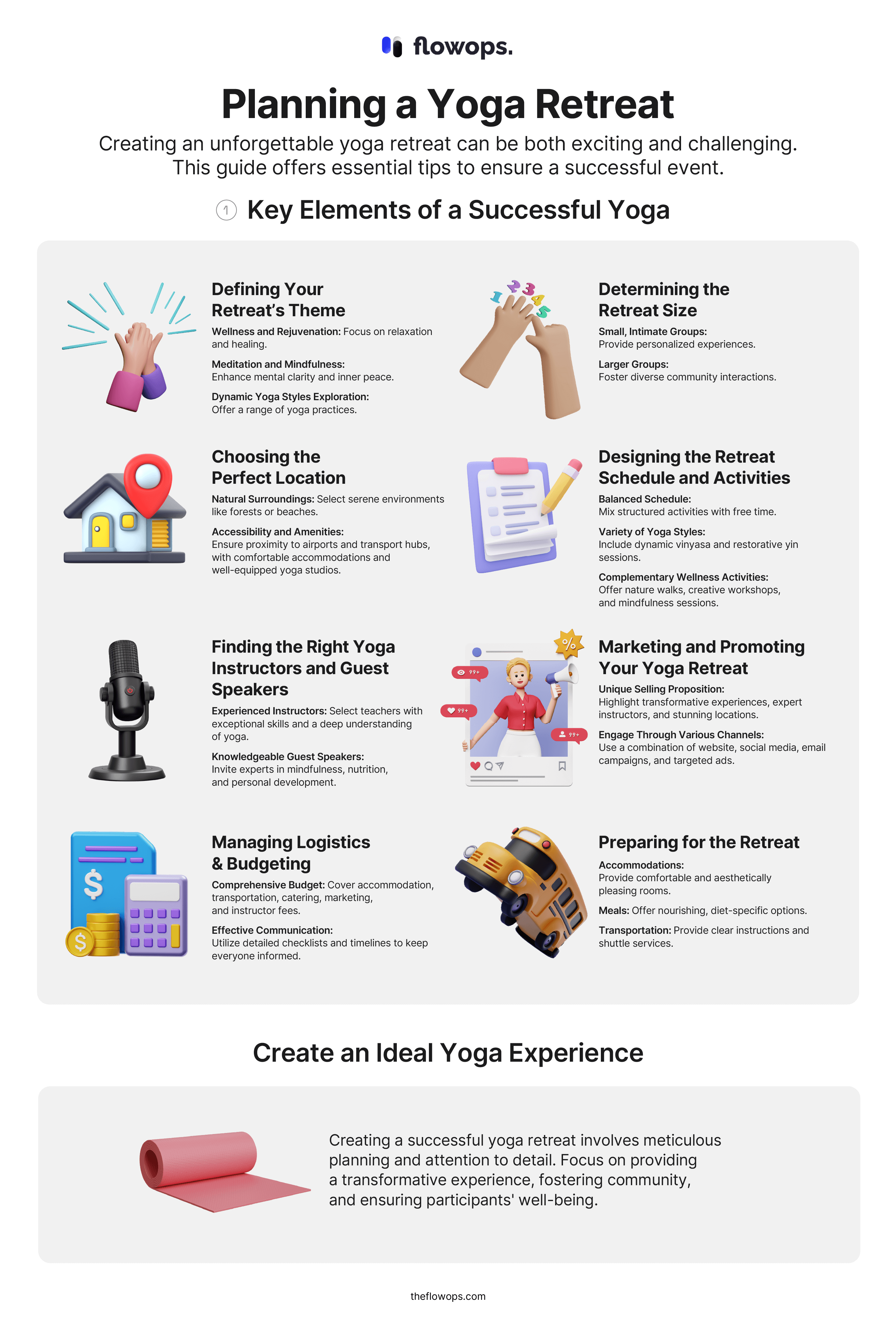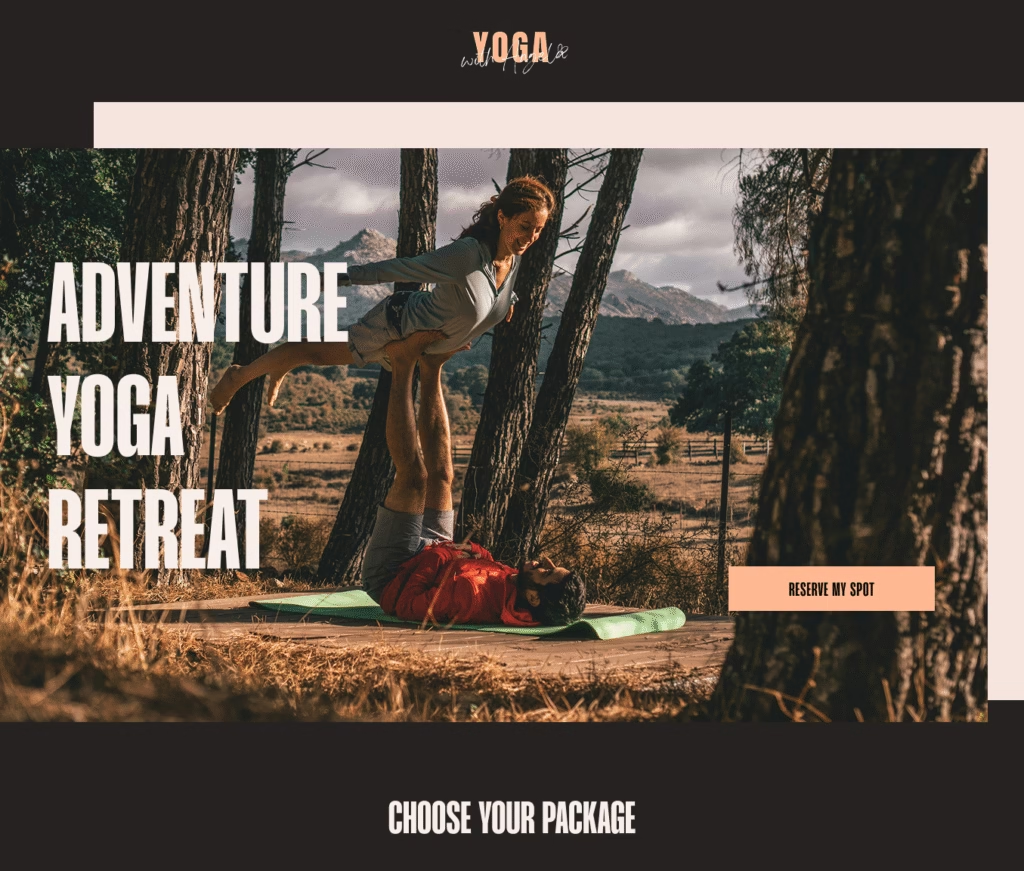Planning a yoga retreat can be an exciting yet challenging endeavor. Whether you’re a seasoned instructor or a passionate yogi wanting to organize a unique experience, this guide is your ultimate resource for creating a retreat you’ll never forget.
Essentially it isn’t just about logistics—it’s about creating a space for transformation. From choosing the perfect retreat venue to crafting a schedule that flows effortlessly, every decision shapes the experience you’re offering.
We know how much heart and intention you’re putting into this, and we’re here to help.
That’s why we’ve gathered expert insights and practical tips to guide you in curating a retreat that feels seamless, meaningful, and deeply impactful—not just for your participants, but for you as a retreat host, too.
Let’s make this an unforgettable experience, together.
In this comprehensive guide, we’ll dive into selecting the perfect retreat destination, crafting a retreat theme that resonates with your target audience, and designing a schedule that balances relaxation and self-discovery. We’ll also explore the logistics of accommodation, transportation, and budgeting, ensuring that every aspect of your retreat is meticulously planned.
Get organized and start planning your next wellness retreat with clarity and confidence using our free Retreat Planning Template.

Whether you envision a serene beachfront escape or a mountain retreat surrounded by majestic peaks, let this guide be your roadmap to creating a yoga retreat that exceeds expectations and leaves your students rejuvenated and inspired. So, let’s get started on creating your unforgettable yoga retreat.
Factors to consider when planning a yoga retreat
Planning a successful yoga retreat requires careful consideration of various factors that can make or break the overall experience for your participants.
As an experienced yoga instructor or retreat organizer, you’ll need to meticulously evaluate each aspect of the yoga center retreat to ensure it aligns with your vision and the needs of your students
Defining Your Retreat’s Theme
Planning successful yoga retreats requires careful consideration of various factors that can significantly influence the overall experience for your participants. One of the primary factors to consider is the retreat’s theme or focus.
Will it be a rejuvenating wellness retreat, a deep dive into meditation and mindfulness, or a dynamic exploration of various yoga styles? Defining the retreat’s theme will help you curate the right activities, workshops, guest speakers, and other yoga instructors you’ve partnered with to create a cohesive and meaningful experience for your participants.
Don’t be afraid to explore various ideas and creative themes for your yoga retreat.
Determining the Retreat Size

Another crucial factor is the size of your yoga retreat. Determining the optimal number of participants can significantly impact the overall dynamics, logistics, and budget of the event.
Smaller yoga retreats may offer a more intimate and personalized experience, while larger retreats can provide a diverse community and a wider range of offerings. Carefully weigh the pros and cons of different group sizes to find the sweet spot that aligns with your goals and resources.
Once you’ve done this, make sure to track sign-ups through a retreat booking form that works for you.
Choosing the perfect location for your yoga retreat
The location of your yoga retreat is a crucial factor that can make or break the overall experience for your participants.
The right location can transport your participants to a serene, rejuvenating environment that enhances their practice and personal growth, while the wrong location can detract from the retreat’s purpose and leave participants feeling unsatisfied.
Evaluating Natural Surroundings
Whether local or overseas, the location of your yoga retreat is crucial to the overall experience for your participants.
The right location can transport your students to a serene, rejuvenating environment that enhances their practice and personal growth, while the wrong location can detract from the retreat’s purpose and leave participants feeling unsatisfied.
When selecting a location, consider factors such as natural surroundings, accessibility, and amenities.
Tying Location to Your Retreat Theme

Moreover, it’s essential to tie the location to the theme of your retreat. For instance, if your retreat focuses on mindfulness and meditation, a tranquil, secluded setting such as a forest retreat or a quiet mountain retreat might be ideal.
Conversely, a retreat centered around dynamic yoga styles and physical rejuvenation might benefit from a vibrant, energizing environment like a beachfront yoga retreat or an urban yoga center retreat with modern facilities. By aligning the location with the retreat’s theme, you can create a cohesive and harmonious experience that enhances the overall impact of your yoga retreat.
Accessibility and Amenities
A picturesque setting with stunning natural landscapes can create a deeply immersive and transformative experience for your students. Additionally, the accessibility of the location, in terms of transportation and proximity to major airports or hubs, can significantly impact the overall convenience and appeal of the retreat.
The amenities of the retreat venue are crucial, as they directly impact the comfort and well-being of your participants. Look for a location that offers comfortable accommodations, well-equipped yoga studios, healthy and delicious dining options, and opportunities for relaxation and self-care, such as spa services or outdoor activities.
To make this process easier, visit TheFlowOps, where you can filter retreat venues using our amenities dropdown. Multi-select the amenities you are looking for, such as yoga shalas, luxury venues, and even amenities like Bluetooth speakers, to find the perfect venue for your retreat.
Designing the retreat schedule and activities

Creating a Balanced Schedule
Crafting a well-balanced and engaging retreat schedule is essential to creating a transformative experience for your participants. The schedule should strike a harmonious balance between structured activities, such as yoga classes and workshops, and ample free time for personal reflection, exploration, and relaxation.
A thoughtfully designed schedule ensures that participants can immerse themselves in the retreat’s offerings without feeling overwhelmed or exhausted.
Incorporating a Variety of Yoga Styles
Begin by mapping out the daily flow of the retreat, ensuring that there is a natural rhythm and progression to the activities. Start each day with a grounding morning practice, followed by a nourishing breakfast and a mix of workshops, discussions, and free time.
Incorporate a variety of yoga styles, from dynamic vinyasa to restorative yin, to cater to the diverse needs and preferences of your students. Including multiple styles not only keeps the sessions engaging but also allows participants to explore different facets of their practice, deepening their overall experience.
Adding Complementary Wellness Activities
In addition to the core yoga and meditation sessions, consider incorporating other wellness-focused activities. Guided nature walks can help participants connect with the natural surroundings and promote mindfulness.
Creative expression workshops, such as art or writing sessions, provide an outlet for self-expression and introspection. Mindfulness-based activities, such as breathwork or sound healing sessions, can further enrich the retreat experience by offering diverse ways to achieve relaxation and self-discovery.
Finding the right yoga instructors and guest speakers

Selecting Experienced Yoga Instructors
The success of your yoga retreat largely depends on the quality and expertise of the yoga instructors and guest speakers you select. These individuals will be the driving force behind the transformative experiences your participants will have, so it’s essential to choose them wisely.
When selecting your yoga instructors, look for individuals who not only possess exceptional teaching skills but also embody the values and principles of yoga.
They should have a deep understanding of various yoga styles and be able to adapt their teaching to the needs and abilities of your retreat participants.
Inviting Knowledgeable Guest Speakers
Additionally, consider inviting guest speakers who can offer unique perspectives on topics such as mindfulness, nutrition, or personal development, further enriching the retreat experience.
Ensure that your chosen instructors and speakers are aligned with the retreat’s theme and are committed to creating a safe, supportive, and transformative environment for your participants. Their ability to connect with the group, inspire and motivate, and create a sense of community can make all the difference in the overall success of your retreat.
Marketing and promoting your yoga retreat

Effective marketing and promotion are crucial to attracting the right participants and ensuring the success of your yoga retreat. In today’s competitive landscape, it’s essential to create a compelling and engaging brand that resonates with your target audience and sets your retreat apart from the rest.
Begin by defining your unique selling proposition and crafting a compelling narrative that captures the essence of your retreat. Highlight the transformative experiences, the expert instructors, and the stunning location to pique the interest of potential participants.
Utilize a variety of marketing channels, such as a well-designed website, social media platforms, email campaigns, and targeted advertising, to reach your audience effectively.
Engage with your community of yogis and wellness enthusiasts by sharing behind-the-scenes glimpses of the retreat planning process and building anticipation for the upcoming event. Encourage past participants to share their experiences and testimonials, as this social proof can be a powerful tool in attracting new participants.
Furthermore, consider collaborating with like-minded influencers, yoga studios, or wellness brands to expand your reach and tap into new audiences.
Seamlessly market your classes with TheFlowOps or grab our free Retreat Marketing Plan Template.

Managing logistics and budgeting for the retreat

Creating a Comprehensive Budget
While budgeting may not be the most glamorous aspect of planning a retreat, it’s essential to ensure you are fairly compensated for the hard work and dedication you put into creating a transformative experience for your students.
From securing the venue (here’s a list of our favorite budget retreat venues) and accommodations to coordinating transportation and catering, every aspect of the retreat should be carefully considered to ensure a seamless experience for your participants.
Begin by creating a comprehensive budget that accounts for all the expenses associated with the retreat. Carefully research and compare different vendors and service providers to ensure you’re getting the best value for your money. Consider the following costs:
- Rental and accommodation fees per night per participant
- Fees incurred for excursions per participant
- Sales and marketing expenses
- Software tools and other related expenses
- Salary or share of earnings for instructors you collaborate with
- Food expenses (which can be avoided if you collaborate with certain venue partners who offer catering as part of their venue offerings)
Remember to factor in a contingency fund and consider obtaining insurance coverage to handle any unexpected expenses or issues that may arise during the planning process or the retreat itself.
Ensuring Effective Communication and Organization
Effective communication and organization are key to managing the logistics of your retreat.
Collaborate with your venue and service providers to ensure that all the necessary arrangements are in place, from room assignments and meal planning to transportation schedules and emergency protocols. Develop detailed checklists and timelines to keep track of all the moving parts and ensure that nothing falls through the cracks.
For your participants, it would be good to prepare a brief on what to expect during the retreat. Before the event, see if you can send updates regarding the schedules, weather conditions and even a packing list of things you recommend that they bring with them.
Preparing for the Retreat: Accommodations, Meals, and Transportation
Finalizing Accommodations
As the date of your yoga retreat approaches, it’s time to shift your focus to the final preparations and ensure that every aspect of the participant experience is meticulously planned and executed.
From the accommodations and meals to the transportation and on-site logistics, every detail should be considered to create a seamless and memorable retreat.
Begin by working closely with your venue partners to finalize the accommodations for your participants. Ensure that the rooms or lodges align with the retreat’s overall aesthetic and ambiance.
Clearly communicate any special requests or needs from your participants to the venue to ensure a comfortable and seamless experience.
Curating the Retreat’s Meals

Curating the retreat’s meals is another crucial component of the participant experience.
You can delegate this task to the venue’s in-house kitchen or a nearby restaurant. Provide them with dietary restrictions and preferences, such as vegan-only or no beef, and they will typically accommodate these requirements and send a menu for your review. This approach ensures that the meals nourish the body and align with the retreat’s theme and values.
If you prefer to be more involved in meal planning and preparation, we’ve prepared a free downloadable guide here for you!
Organizing Transportation Logistics
Lastly, ensure that the transportation logistics are well-organized and clearly communicated to your participants.
Obtain PDF materials from your accommodation or venue partner that include detailed instructions on how to arrive at the retreat location, and forward these to your participants.
Consider offering shuttle services or coordinating group transportation to make the journey as seamless as possible. Attending to these final details can help create a retreat experience that exceeds your participants’ expectations, leaving them feeling rejuvenated, inspired, and eager to return.
Build Your Retreat Website—Without the Tech Headache
Once you’ve got your retreat vision, location, and dates locked in, the next big step is getting the word out.
And nothing does that better than a well-crafted website.
Your website is more than just a place to list details—it’s your retreat’s digital home. It sets the vibe, answers questions, builds trust, and (most importantly) gives people a clear path to sign up.
But if the idea of building a site sounds overwhelming, don’t worry—we’ve got you.
TheFlowOps is a website builder made just for yoga teachers and wellness facilitators. No coding, no tech jargon—just easy, intuitive tools to help you launch quickly and beautifully.
With TheFlowOps, you can:
- Choose from ready-made retreat templates designed to convert interest into bookings
- Share all the essentials—venue, inclusions, daily flow, testimonials, and pricing
- Accept bookings and payments directly on your site
- Send automated confirmation emails to make guest communication seamless
- Start with a free 7-day trial (no credit card needed!)
Conclusion
Creating a successful yoga retreat is a labor of love that demands meticulous planning, attention to detail, and a deep understanding of your participants’ needs and desires. By carefully considering the factors outlined in this guide, you can curate a transformative experience that leaves a lasting impact on your participants.
From selecting the perfect location to crafting a balanced schedule and finding the right instructors, each aspect of the retreat planning process plays a crucial role in creating an unforgettable experience. Investing time and effort in these elements will help you cultivate a retreat that not only rejuvenates the body and mind but also fosters a sense of community, personal growth, and a deep connection with the practice of yoga.
As you embark on your journey of planning the unforgettable yoga retreat, remember that true success lies in the transformative experiences your participants will have. Focus on the key impact you want your participants to walk away with, whether it’s a deeper understanding of their practice, enhanced well-being, or a renewed sense of purpose.
Prioritize their well-being, create a safe and supportive environment, and infuse each moment with intention and authenticity. Make sure you are also aware of the common mistakes when booking a yoga retreat. By doing so, you can unlock the power of yoga to inspire, heal, and uplift the lives of those who attend your retreat.
Embrace the challenges, trust the process, and let your passion for yoga guide you in creating an unforgettable experience that will resonate with your guests for years to come.
Ready to find the perfect venue for your retreat? Visit retreats.theflowops.com.
And so you can take the guesswork out of planning, download our free Retreat Planning Guide Template (PDF) and start mapping out your perfect retreat today.




